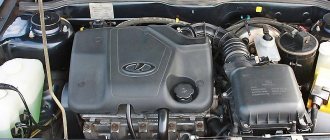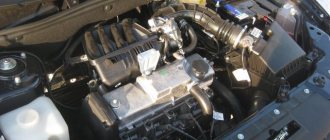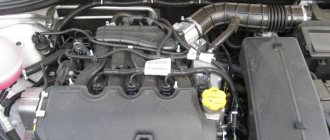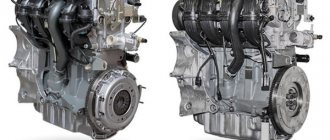Engine
Lada Priora has undergone changes several times, both externally and technically. The appearance, power plant and transmission changed.
Below is an example of engines that were installed on the VAZ 2170-72.
Engine 21116 (8 valves)
This engine was installed on the VAZ 2114 and Lada Kalina, and was later inherited by the Priora. The power of this internal combustion engine is 80 hp. with a volume of 1.6 liters, which is very small. Such an engine does not have good dynamics, and it is difficult for it to “drag” the body of the Priora.
Pros:
- Does not bend valves;
- Easy to maintain;
- Cheaper spare parts;
Minuses:
- Low power;
- Noisiness;
The installation of such an engine continued until 2022.
Engine 21126 (16 valves)
16 valve engine with more power and torque compared to 116. It is a modified model of the 124 engine. Its power is 98 hp. with a volume of 1.6 liters.
Pros:
- Great power;
- No noisy operation;
Minuses:
- Bend valves when the belt breaks;
- Expensive spare parts;
Engine 21127 (16 valves)
The modified 126 engine received the index 21127; the intake in this engine was changed, thereby increasing the power to 106 hp. with the same volume of 1.6 liters. They began to install a new cable gearbox for this engine.
Pros:
- High power;
- No noisy operation;
Minuses:
- Bend valves;
- Expensive spare parts;
Engine 21128 (16 valves)
This engine was specially designed for more powerful Lada cars with the “Super Auto” nameplate. The power of this engine has increased, as has its volume. The number of horsepower in the super car engine increased to 123, and the volume to 1.8 liters, which radically affected the dynamics of the car.
Pros:
- Good dynamics and high power;
Minuses:
- Bend valves;
- More expensive spare parts;
Specifications
| Manufacturer | Concern "AvtoVAZ" |
| Start year of release | 2007 |
| Volume, cm³ | 1597 |
| Power, l. With | 98 |
| Torque, Nm | 145 |
| Compression ratio | 11 |
| Cylinder block | cast iron |
| Number of cylinders | 4 |
| Fuel injection order | 1-3-4-2 |
| cylinder head | aluminum |
| Cylinder diameter, mm | 82 |
| Piston stroke, mm | 75.6 |
| Number of valves per cylinder | 4 |
| Timing drive | belt |
| Turbocharging | No |
| Hydraulic compensators | There is |
| Valve timing regulator | No |
| Lubrication system capacity, l | 3.5 |
| Oil used | 5W-30, 10W-40 |
| Fuel supply system | injector, distributed injection |
| Fuel | gasoline AI-95 |
| Environmental standards | Euro 3 (4)* |
| Resource, thousand km | 200 |
| Location | transverse |
| Weight, kg | 115 |
| Tuning (potential) l. With | 400** |
*toxicity standards vary depending on the model of the installed collector (for Euro 4 model 11194-1203008-00(01)); ** without loss of resource up to 120 l. With
Engine test tables and graphs
Comparison of Priora engines 1.8 and 1.6 liters
As you can see from the table, the power of the 1.8 liter engine has a positive effect on its dynamics and even consumption. It would seem that it is fuel consumption that should increase, but test results prove the opposite.
Engine power
In this graph, the favorite is immediately visible; there are practically no equal to the 1.8-liter engine.
Recommendations for improvement
For the first time, it was decided to increase the power of the new Priora 21126 engine at the factory in order to create a sports modification of it. Camshafts with increased lift, a lightweight connecting rod and piston group were installed, and the intake and exhaust tracts were modified. This is how the first domestic sports unit appeared, which was put into production, and they began to install it on the Lada Granta Sport model.
The technical characteristics of the engine are as follows: engine power from the Priora has increased to 118 hp. torque - up to 154 Nm at 4700 rpm, fuel consumption also increased to 7.8 liters per 100 km with a combined driving cycle. We will give a number of recommendations on how to independently increase the power of Priora engines:
- The simplest and most affordable way is to install a zero-resistance exhaust tract. The essence of its work is to reduce the resistance of the path, as a result of which some of the power spent on overcoming this resistance will be released and become useful.
- The same operating principle applies to the zero-resistance intake tract. Installing the receiver and throttle body to 56 mm will allow the power unit to “breathe” more freely, and your Lada Priora will become several horsepower more powerful.
- Deeper tuning - new camshafts with a sports configuration, allowing the intake and exhaust valves to open more. This will give a noticeable increase in the agility of the car, especially in city conditions.
- Replacing the standard valves and connecting rod-piston group with a lightweight one will again release some of the useful energy of the unit and add it to the main power. Here you can kill two birds with one stone: install pistons with recesses, thereby eliminating the possibility of them “meeting” with the valves when the timing belt breaks.
- We should not forget about CHIP tuning. After major changes in the engine configuration, its operating mode will definitely improve, and in order to optimize it and adjust fuel consumption, you need to do a flashing.
Recommendations are given taking into account that the power plant is in good technical condition. If this is not the case, when tuning it is worth replacing worn parts and oil in order to get the desired effect from the changes. As a result of the above measures, the Lada Priora will receive an additional 20-30 hp. without reducing the resource.
How many horses can Priora have in addition to this? Quite a lot, there are capabilities and components to increase the power ultimately to 400 hp. This is due to a radical modification of the power plant: boring the cylinders, grinding the cylinder head, replacing the injectors and fuel pump with more efficient ones, installing four throttle valves and a turbocharger.
We should not forget about modernizing the brake system. Such tuning will give excellent results in terms of power, but the engine life will be significantly reduced, and fuel consumption, on the contrary, will increase significantly.
Compressor for Priora
An alternative method of obtaining such power is to install a compressor, for example, the most popular option is an Auto Turbo kit based on PK-23-1, this compressor is easily installed on a 16-valve Priora engine, but with a lower compression ratio. Then there are 3 options: 1
.
The most popular is to lower the coolant gasket with a gasket from a twelve-wheeler, install this compressor, exhaust on 51 pipes, Bosch 107 injectors, install it and go to the track to watch the car go downhill. But the car doesn’t run very well... then running to sell the compressor, writing that the Autoturbo doesn’t work and all that... is not our option. 2
.
We lower the coolant by installing a thick cylinder head gasket from 2112, for a St. Petersburg supercharger at a pressure of 0.5 bar this will be enough, we select the optimal narrow-phase shafts (Nuzhdin 8.8 or similar), exhaust 51 pipes, Volga BOSCH 107 injectors, a receiver and a standard throttle body. To fully push the configuration, we give the cylinder head to cut the channels, install larger lightweight valves, this is not expensive and will provide additional power throughout the entire range. This whole thing needs to be configured online! We’ll get an excellent motor with a power of more than 150-160 hp that can perform in any (!) range. 3
. We lower the coolant by replacing the piston with a tuning one for the turbo, you can put a proven Nivov piston with a puddle under the turbo on 2110 connecting rods, on such a config you can put a more efficient compressor, a Mercedes one for example, blowing 1-1.5 bar with a power well over 200+ hp . and act like the devil! ) The advantage of the config is the ability to install a turbine on it in the future and blow out at least all 300+ hp. if the piston doesn't go to hell))
Are the valves bending?
In Lada Priora cars, even in a 16-valve 126 power unit, valves can often bend. The reasons causing this defect lie in non-compliance with operating rules, in case of violation of the regulations for replacing the following components and parts:
- rollers;
- timing belt;
- water pump.
If one of the listed components breaks down, the pistons, exerting mechanical stress on the valves, can bend them. The design features of the engine are the reasons why the engine can bend valves. Deformation of the valves necessitates a major overhaul of the Priora engine.
To avoid this defect, the car owner needs to timely check the timing elements. Of particular importance is the belt, which is subject to thorough inspection after 50 thousand kilometers. When checking, the following faults are excluded:
Error codes
In error mode, the computer may display the following codes:
After troubleshooting, you need to reset the error. If no action is performed within 20 seconds, the on-board computer goes into normal operation.
How to perform diagnostics using a standard on-board computer
In the absence of additional diagnostic tools, errors that are read by the Priora ECU can be displayed on the instrument panel in the standard way. To do this you need:
- While holding the mileage reset button, turn on the ignition. After pressing for 4 seconds, the instrument panel begins to move (all indicators light up, instrument arrows rotate around the axis several times, the LCD display turns on all registers). This indicates that the self-diagnosis mode has turned on.
- On the right steering column switch, the Reset button selects the position for displaying the firmware version, error code, and error reset.
How to replace the Priora ECU
There can be many reasons for replacing the controller: the desire to install another model that can work with more efficient firmware, failure, incorrect operation.
You can find out which ECU is on the Priora using the diagnostic method, or by using the firmware identifier, which can be checked on a special website. Bosch M 10 and “January-7” controllers are installed on cars.
In order to change the ECU, you need to do the following:
- Disconnect the on-board system from the battery. To do this, simply remove the negative terminal.
- Remove the plastic lining of the tunnel on the right side.
- Push the bracket securing the connector with the bundle of wires all the way.
- Remove the block with wires.
- Unscrew the 2 nuts in the place where the Priora ECU is attached to the bracket.
- Lift the controller up and remove it through the right side.
As can be seen from the description, the procedure is very simple and does not take more than 5-10 minutes. Installation occurs in reverse order.
Engine tuning Priora 21126 1.6 16V
Chip tuning of the Priora engine
As a pampering activity, you can play with the sports firmware, but there will be no obvious improvement; see how to properly increase the power below.
Priora engine tuning for the city
There are legends that the Priora’s engine produces 105, 110 and even 120 hp, and the power was underestimated to reduce taxes, various measurements were even taken in which the car produced similar power... what everyone decides to believe, let’s focus on the indicators declared by the manufacturer. So, how to increase the power of a Priora engine, how to charge it without resorting to anything special, for a small increase you need to let the engine breathe freely. We install a receiver, a 4-2-1 exhaust, a 54-56 mm throttle body, and we get about 120 hp, which is quite good for the city.
Boosting the Priora engine will not be complete without sports camshafts, for example, STI-3 camshafts with the configuration described above will provide about 140 hp. and it will be fast, an excellent city motor. The refinement of the Priora engine goes further, sawn cylinder head, Stolnikov 9.15 316 shafts, light valves, 440cc injectors and your car easily produces more than 150-160 hp.
What data goes to the controller
The Priora ECU operates in the mode of continuous reading of information from sensors. Based on this information, the computer makes decisions about changing the operating modes of the engine systems. The types of data entering the controller are as follows:
- electrical voltage in the car network;
- presence of detonation in combustion chambers;
- vehicle speed;
- cooling system temperature;
- amount of oxygen in exhaust gases;
- air flow;
- temperature of the air entering the intake manifold;
- position of the camshaft and crankshaft;
- throttle position.
Types of ECU memory
In order to perform its functions, the controller has to operate with a lot of data. Some of them are constantly in operation, others are loaded periodically. Therefore, memory is divided into three types:
- PROM is a programmable read-only memory device. It contains the so-called firmware - a program that controls engine operating parameters, such as fuel injection timing, ignition angle advance control, idle speed, as well as calibration data. This type of memory is retained when there is no power. Data changes are made using reprogramming.
- RAM is a random access memory device. Performs the same function as the RAM of a regular computer - temporary storage of information during one working session. This memory receives sensor data, stores diagnostic codes, as well as intermediate information about the activity of the microprocessor. It requires electric current to operate.
Engine Lada Priora 2171. Description and design of the engine.
Engine Lada Priora 2171. Description of the engine. Engine structure.
The VAZ 2171 Lada Priora is equipped with a VAZ 21126 engine, which is based on the VAZ 2112 engine. An increase in engine displacement to 1.6 liters was achieved by increasing the piston stroke while keeping the cylinder diameter unchanged.
The cylinder block is cast from special high-strength cast iron, which gives the engine structure rigidity and strength. The coolant ducts that form the cooling jacket are made along the entire height of the cylinder block, this improves the cooling of the pistons and reduces the deformation of the cylinder block from uneven overheating. The cooling jacket is open at the top towards the cylinder head.
At the bottom of the cylinder block there are five crankshaft main bearing supports, the caps of which are bolted on. The supports are equipped with thin-walled steel-aluminum liners that serve as crankshaft bearings.
The middle support has grooves into which thrust half-rings are inserted, holding the crankshaft from axial movements. The crankshaft is cast from special high-strength cast iron. The main and connecting rod journals of the shaft are ground. To lubricate the connecting rod bearings, oil channels are drilled in the crankshaft and closed with plugs.
To reduce vibration, eight counterweights are located on the crankshaft. To distinguish the shafts, the marking “11183” is cast on one of the counterweights of the crankshaft of the VAZ 21126 engine.
At the front end of the crankshaft there is an oil pump, a timing belt pulley and an alternator drive pulley with a built-in vibration damper.
At the rear end of the crankshaft there is a flywheel cast from cast iron. A steel toothed rim is pressed onto the flywheel. The connecting rods are steel, forged, with covers on the lower heads. The connecting rod caps are made by tearing them off from a solid connecting rod. This achieves higher accuracy of installation of the cover on the connecting rod. Thin-walled liners are installed in the lower head of the connecting rod, and a steel-bronze bushing is pressed into the upper head.
The pistons are cast from aluminum alloy. Each of them has three rings installed: two upper compression rings and a lower oil scraper ring. The piston bottoms are flat, with four recesses for the valves. The pistons are cooled by oil, for which special nozzles are installed in the main bearing supports. They are tubes containing spring-loaded balls.
While the engine is running, the balls open holes in the tubes, and a stream of oil hits the piston from below. In the engine mod. 21126, a “piston-piston rings-piston pin-connecting rod” set of reduced weight was used (the weight of the piston was reduced from 350 to 235 g, the piston pin - from 113 to 65 g, the connecting rod - from 707 to 485 g, the entire set - by 32%) .
The oil sump is steel, stamped, bolted to the cylinder block from below. The cylinder head, mounted on top of the cylinder block, is cast from aluminum alloy. At the bottom of the block head, channels are cast through which liquid circulates, cooling the combustion chambers.
At the top of the head there are two camshafts: one for the intake valves, the other for the exhaust valves. The camshafts are installed in supports made in the upper part of the cylinder head, and in one common bearing housing bolted to the cylinder head. The camshafts are cast from cast iron.
To reduce wear, the working surfaces of the cams and the surfaces under the oil seal are heat-treated - bleached. The camshaft cams operate the valves through tappets. The 21126 engine is equipped with hydraulic valve lifters, which automatically compensate for gaps in the valve drive. The engine has mod. 21126 during operation there is no need to adjust the clearances in the valve mechanism.
The engine has four valves per cylinder: two intake and two exhaust. The guide bushings and valve seats are pressed into the cylinder head. The guide bushings are also equipped with locking rings that keep them from falling out.
Oil scraper caps are installed on the guide bushings to reduce oil penetration into the cylinders. Each valve has one spring installed. The camshafts are driven by a rubber toothed belt from the crankshaft.
The cylinder head cover is made of aluminum. The joint between the cover and the cylinder head is sealed with a gasket. The cylinder head cover of the 21126 engine differs from the 2112 cover in the absence of a platform for mounting the ignition module and the presence of holes for mounting individual ignition coils next to the spark plug wells.
The engine lubrication system is combined: splash and pressure. Main and connecting rod bearings and camshaft supports are lubricated under pressure. The system consists of an oil sump, gear oil pump with oil receiver, full flow oil filter, oil pressure sensor and oil passages.
The engine cooling system consists of a cooling jacket, a radiator with an electric fan, a centrifugal water pump, a thermostat, an expansion tank and hoses.
The engine power system includes an electric fuel pump installed in the gas tank, a throttle assembly, a fine fuel filter, a fuel pressure regulator, injectors, and fuel hoses.
The power system functionally includes a fuel vapor recovery system with a carbon adsorber, which prevents the release of fuel vapor into the atmosphere.
The ignition system consists of individual ignition coils mounted on the cylinder head cover and spark plugs. The ignition coils are controlled by the engine's electronic control unit (ECU). Installation of individual ignition coils instead of the engine ignition module mod. 2112 made it possible to eliminate high-voltage ignition wires and improve the technical characteristics and reliability of the system.
The engine crankcase ventilation system is closed, with crankcase gases being removed through the oil separator separator installed in the cylinder head cover into the intake pipe. Next, the crankcase gases are sent to the engine cylinders, where they burn.
When the engine is idling, crankcase gases flow through a small circuit hose through a calibrated hole (nozzle) in the throttle body. In this mode, a high vacuum is created in the intake pipe, and crankcase gases are effectively sucked into the throttle space. The jet limits the volume of sucked gases so that engine idle operation is not disrupted.
The most basic malfunctions of the 126 engine
Let's move on to the malfunctions and shortcomings, what to do if the Priora engine is running rough, sometimes flushing the injectors solves the problem, it may be the spark plugs or the ignition coil, but the usual thing in this case is to measure the compression in order to eliminate the problem of valve burnout. But the cheapest option is to go to a service center for diagnostics.
Another common problem is when the engine speed of the Priora 21126 fluctuates and the engine runs unevenly, a common disease of VAZ sixteen valves, your mass air flow sensor is dead! Not dead? Then clean the throttle valve, there is a possibility that the TPS (throttle position sensor) needs to be replaced, perhaps the IAC (idle air regulator) has arrived. What to do if the car does not warm up to operating temperature, perhaps there is a problem with the thermostat or the frost is too severe, then you will have to put cardboard on the radiator grill. Regarding overheating and warming up, is it necessary to warm up the engine? Answer: it definitely won’t get worse, warm it up for 2-3 minutes and everything will be fine. Let's return to the jambs and problems of engines, your Priora engine does not start, the problem may be in the battery, starter, ignition coil, spark plugs, fuel pump, fuel filter or fuel pressure regulator. The next problem is that the Priora engine is noisy and knocking, this occurs on all Lada engines. The problem is in the hydraulic compensators; the connecting rod and main bearings can knock (this is already serious) or the pistons themselves. You feel vibration in the Priora engine, the problem is in the high-voltage wires or in the IAC, perhaps the injectors are dirty.
Boring the Priora engine or how to increase the volume
Let's start with how you don't need to increase the volume, an example would be the famous VAZ 21128 engine, don't do that)). One of the easiest options to increase volume is to install a motorcycle kit, for example STI, we choose it for our 197.1 mm block, but do not forget about the jambs of the 128 engine, do not rush to install a long-stroke elbow. You can go the other way and purchase a high block 199.5 mm Priora, 80 mm crankshaft, bore the cylinders to 84 mm and a connecting rod 135.1 mm pin 19 mm, this will give a total of 1.8 volume and without damage to R/S, the engine can be twist freely, install evil shafts and squeeze out more power than a regular 1.6l. To spin your engine even more, you can build up a standard block with a plate, how to do it, how it spins on a 4-throttle intake and wide shafts.











